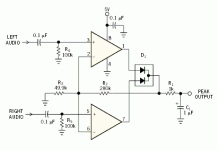in the past ive used a lame single comparator as a one LED output level indicator. ive used rectification, no rectification, and even frequency-level compensation for a guitar... but whats the easiest, most simple, and fewest components required circuit for this job? if i just use a comparator and LED won't it be turning on and off at AF? ...sounds noisey to me. any suggestions?
greg
greg
Try something like the attached circuit. This will provide a peak level output indication. You can connect its output to the input of a comparator & LED or a bar-graph display (e.g. using a LM3915) or whatever.
R1*C1 sets attack time. (R2+R2)*C1 sets the decay time, which is a lot longer than the attack time, resulting in the peak detecting functionality. The gain is set at 5 in this schematic, but can be adjusted accordingly. You don't have to use a dual diode for D1; two normal small-signal diodes will work too. Any standard dual opamp (with rail-to-rail output) that can run off a single 5 V supply should work fine. If you only need 1 channel of input, then just remove R5, it's input cap, and one half of D1. You can use the 2nd half of the opamp as the comparator to turn on an LED. To use this at the output of an amp, put a pot at the input (100 K should be fine). Adjust this pot so that the output of this circuit is, say, 2 V when the amp outputs at "0 dB". Connect the output to a comparator that turns on an LED when its input is above 2V.
R1*C1 sets attack time. (R2+R2)*C1 sets the decay time, which is a lot longer than the attack time, resulting in the peak detecting functionality. The gain is set at 5 in this schematic, but can be adjusted accordingly. You don't have to use a dual diode for D1; two normal small-signal diodes will work too. Any standard dual opamp (with rail-to-rail output) that can run off a single 5 V supply should work fine. If you only need 1 channel of input, then just remove R5, it's input cap, and one half of D1. You can use the 2nd half of the opamp as the comparator to turn on an LED. To use this at the output of an amp, put a pot at the input (100 K should be fine). Adjust this pot so that the output of this circuit is, say, 2 V when the amp outputs at "0 dB". Connect the output to a comparator that turns on an LED when its input is above 2V.
Attachments
- Status
- Not open for further replies.
